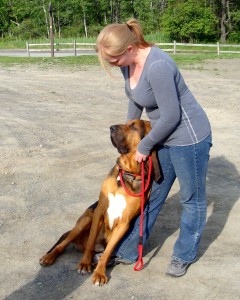I love dog training. I’m pretty sure I have ALWAYS loved dog training, from when I was a young child and accidentally taught our collie to shake hands. One thing about training dogs is that there are more techniques out there than you can shake a stick at.
Clicker training, force free training, balanced training, e-collar training. Those are just a few. In my journey to become a helper to animals and their families, I’ve dabbled in many training methods.
However, of all of these training methods, styles, and techniques that I have used in my career as a dog trainer, there is one that has shaped the way I work with animals more than any other. Synalia Training Systems, or SATS, has many aspects that set it apart from the others, and make it the most effective dog training technique I have found.

Where does SATS come from?
The history of this technique itself is a completely fascinating story of an outstanding and innovative trainer. SATS was developed by an incredible woman named Kayce Cover through her work with exotic animals in some of the top zoos and oceanariums, and universities in the United States (and the world). In her work with these animals, animals which cannot generally be forced to do anything the way domestic animals can be (ever see a lion handler shove a 400 lb lion into a crate when he doesn’t want to go?), she created techniques that focus on gaining cooperation and introducing true communication with the animals.
I learned about SATS when I was 17, and I have been using it in my training for the last 13 years as a trainer. I use it to solve incredibly difficult problems, help dogs with anxiety and reactivity, and even for simple things, like teaching basic manners. SATS is different from other methods in several ways, and they are ways that make a world of difference.
Want to learn more about training? Join our mailing list and get access to my FREE mini-course!
What makes these theories special?
The differences between SATS and other techniques may seem small or inconsequential, but when put all together, they create a completely different way of teaching, training, and living with animals.

1. SATS is a blend of Behavioral and Cognitive Learning
The majority of animal training techniques that are currently used in the industry are based solely on behavioral principals. Remember B.F. Skinner and his rats? The majority of techniques capitalize on the great power of Operant Conditioning, which states that all behavior is learned through its consequences. Whether a behavior is reinforced and strengthened by rewards, or it is diminished by punishment, how the behavior ends up is based on what happens immediately afterward.
Cognitive learning theory, on the other hand, is based on the belief that learning is accomplished through observing, categorizing, and generalizing. Not simply through trial and error to see what happens when something is tried, but actually through a deeper understanding of what is involved in that behavior or concept, and how it relates to the world in general.
SATS is the only technique that I’ve come across that deliberately teaches animals, not just that the behaviors they display have positive or negative consequences, but that those behaviors can be explained, understood, and expanded into greater concepts through a simple, but effective tool called Name and Explain.
2. SATS is based on mutual respect and responsibility.
Most dog training techniques have a focus on respect, which is important. Without an animal that respects his owner or handler, there is no training relationship. However, SATS is a little bit different, because its focus is not just on the animal respecting the handler, but on the handler respecting the animal as well.

Essentially, it breaks down to this: I need my animals to respect and understand that what I have to teach them is meaningful, important, and is not negotiable. I am the decision maker in the relationship, for the safety and well-being of all involved. However, I also need to respect that the animals I train are their own people. They are each individuals, with specific interests, motivations, and drives. And, I also need to respect that, without the animal’s cooperation, nothing would be accomplished (and it’s quite possible that I would end up hospitalized or dead).
We, as humans, often take for granted that our dogs (or horses, or birds, or sheep, or whatever), must respect and follow us simply because we are human. However, it will take your entire experience with your dog to the next level to understand them for who they are, and to respect their unique intelligence and individuality. This respect leads to the leader/follower relationship that we all crave with our animals.
3. SATS is entirely based on clear communication.
While this is true in every other training method that I’ve used and am familiar with, SATS has a truly unique set of tools that create completely effortless communication with your dog. When all of these tools are used together and fluently, it feels like you are having an actual conversation with your animal, which is the most amazing feeling in the world. To create this common language between you and your dog, SATS uses:
- Bridges – two types of sounds that indicate for your dog when he is on the path to success, and when he has achieved the goal. How we tell the dog that he’s right.
- Targets – a point in space to help explain to the dog what or where he needs to go in order to be successful. You can have hand targets, pole targets, stationary targets, and even visual targets. All of them work to get your dog into the right spot so that he can be correct!
- Name and Explain – easily the simplest aspect of SATS, but also the most under-utilized and unique to this technique. Simply naming things in your dog’s environment that he reacts to, and explaining to him what he needs to do in order to stay successful. It’s as easy as that!
4. SATS works with any other type of training style.

If you choose to become a SATS Trainer, like I am, that’s great. SATS is a wonderful stand-alone technique. However, especially for those who have some experience (or even a LOT of experience) with other types of training, switching over to a completely new method can be difficult. In that case, SATS can be used to make any other method a little bit more straightforward for your dog and easier for him to understand by using the communication tools that we touched on above.
For example, clicker training is a very popular training technique, and for good reason. It’s superbly effective in teaching new behaviors. However, if you find yourself stuck with a problem that you can’t seem to solve with clicker training, bringing in some Name and Explain or target use can completely change the game for you!
Where to learn more about SATS.
There is so much to learn about this awesome technique, and I wish that I could fit it all into one post. Don’t worry, if you’re looking for more information on SATS, there are plenty of resources out there for you (including more posts here on this blog). Check these ones out to get you started:
Visit synalia.com. This is Kayce’s website, and is full of awesome information on the technique and her own courses that can help you get started!
Visit Synalia’s YouTube channel to see this technique in action!